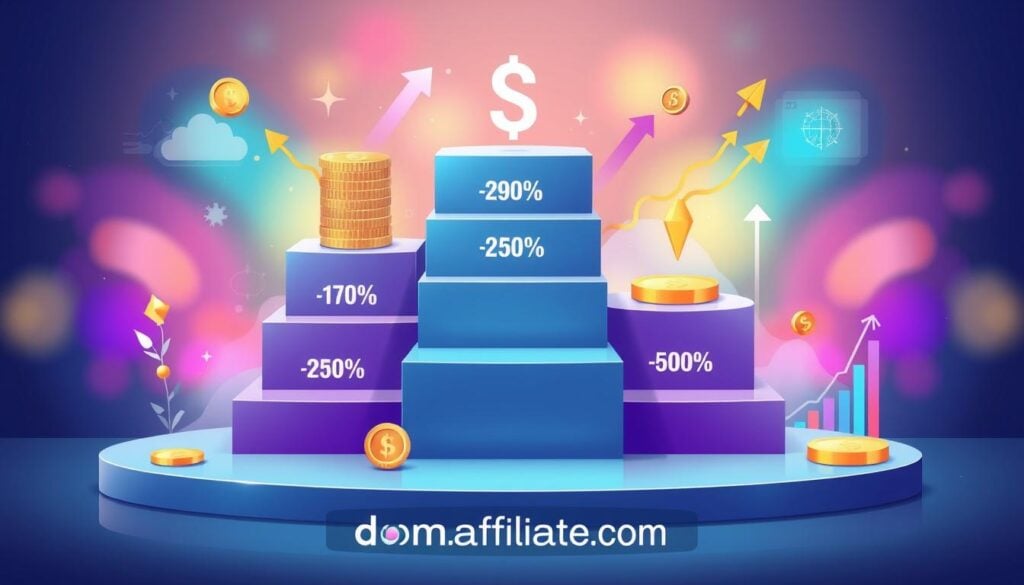Understanding Affiliate Commissions: Structures, Payments, and Profitability
The affiliate marketing world has grown to a $17 billion industry, with understanding affiliate commission and affiliate program selection becoming increasingly crucial for marketers. It’s expected to hit $40 billion by 2030. This method lets people implement various affiliate marketing strategies to promote products and earn money when sales happen. It’s a digital strategy that has transformed marketing, making it easier and more profitable through optimized commission rates and structures.
While this guide focuses specifically on commission structures, understanding how these financial mechanisms fit into the broader affiliate marketing ecosystem is essential. For a comprehensive overview of all aspects involved in scaling your operation, see our complete guide on Affiliate Marketing Intermediate Level: Taking Your Business to the Next Stage.
Key Takeaways
- The affiliate marketing industry is valued at $17 billion, with revenue share calculation showing projected growth to $40 billion by 2030.
- 83% of marketers use affiliate marketing strategies to raise brand awareness.
- The average annual commission rates and structures range between 5-30%, based on commission benchmarking data.
- Revenue share calculation and percentage commissions are the most popular affiliate payment methods.
- Understanding net margin commission splits and maximizing affiliate earnings is crucial in setting competitive commission rates.
The Evolution of Affiliate Marketing in 2024
Affiliate marketing is rapidly evolving, with affiliate tracking metrics becoming more sophisticated in 2024. The industry’s worth of $17 billion and adoption by 83% of marketers demonstrates its growth and innovation in affiliate program selection.
Key Industry Statistics and Trends
Several trends are shaping affiliate marketing, including diverse marketing strategies, global expansion, and mobile commerce focus. Brands are implementing fraud detection mechanisms and multi-touch attribution models to maintain program integrity.
Brands are enhancing support for affiliates through affiliate management software and content creation tools to boost performance.
Impact on Digital Commerce
Affiliate marketing significantly influences digital commerce through revenue forecasting techniques and performance-based bonuses. It enhances business reach and product sales while improving SEO visibility.
| Affiliate Marketing Statistics | Percentage |
|---|---|
| People who prefer using video to learn about a product or service | 72% |
| Viewers more likely to remember a call to action after watching a video | 95% |
| Consumers who have made a purchase after watching a video | 88% |
The future of affiliate marketing looks bright. We’ll see more partnerships between brands and influencers. They’ll focus on sales and using data to grow revenue3. Big brands and software companies will use it even more in 20243.
“Affiliate marketing is a cost-effective way for companies to increase sales and brand exposure, especially in the Australian market.”
Understanding Affiliate Commissions: Core Concepts
Affiliate commissions are fundamental to the ecosystem, with affiliate payout thresholds and affiliate payroll processing being key considerations. Commissions are paid through various affiliate payment structures, including percentage-based, fixed-amount leads, and tiered systems.

In pay-per-sale programs, an affiliate gets a share of the sale price, usually between 5% and 30%5. The commission rate depends on things like industry standards, profit margins, and how much a customer spends over time5. Pay-per-lead programs pay for actions like filling out forms or signing up for services5.
Pay-per-click (PPC) programs reward affiliates for bringing people to a merchant’s site5. Earnings-per-click (EPC) shows the average earnings per 100 clicks across all affiliates5. There are also pay-per-install programs that pay for app or software downloads5.
Affiliate marketing is booming, with over 80% of marketers using it to boost brand awareness6. It helps bring in more customers and sales, as affiliate customers often spend more online6.
To succeed in affiliate marketing, programs need to keep improving, sometimes every week6. Knowing how affiliate commissions work helps marketers use this powerful tool to its fullest6.
| Affiliate Commission Structure | Description | Typical Commission Rates |
|---|---|---|
| Revenue Share | Percentage of sale price | 5% to 30% |
| Pay-per-Lead | Compensation for completed actions (e.g., form submissions, sign-ups) | Varies based on lead value |
| Pay-per-Click (PPC) | Earnings based on redirecting consumers to the merchant’s website | Earnings-per-click (EPC) metric |
| Pay-per-Install | Compensation for driving users to download mobile apps or software | Varies based on app value |
“Affiliate marketing is a rapidly growing segment of the digital marketing ecosystem, with over 80% of marketers incorporating affiliate strategies to enhance brand recognition.”
Essential Participants in the Affiliate Ecosystem
The affiliate marketing world connects merchants, affiliates, and networks through affiliate contract negotiations and detailed affiliate disclosure requirements. They collaborate for successful partnerships and profits while adhering to affiliate taxation guidelines. Merchants offer products or services, set commission rates, and decide how to pay7.
Role of Merchants and Advertisers
Merchants range from solo entrepreneurs to big companies7. They work with affiliates to find new customers and increase sales. They use different payment models like PPC, PPS, PPL, and PPA7.
The PPS model is the most common, where affiliates get paid for each sale7.
Affiliate Publishers and Their Functions
Affiliate publishers are key to the system, using various marketing strategies to promote products7. They use blogs, social media, videos, ads, and emails to earn commissions7. Over 80% of affiliates mix these methods to reach more people8.
Affiliate Networks as Intermediaries
Affiliate networks are important for connecting merchants and affiliates7. They handle the technical side, making sure affiliates get credit for their work8. Consumers drive the success of these partnerships, with their choices affecting everyone8.
The affiliate marketing world is complex but vital for success78. Knowing how each part works is key for those wanting to use affiliate marketing78.
Commission Structure Types and Models
Commission structures are key in affiliate marketing. They reward affiliates for their hard work. In today’s digital world, many commission models have come up. Each one fits the needs of merchants and advertisers9.
The revenue share model is popular. Affiliates get a percentage of sales they help make. This encourages them to focus on big sales9. On the other hand, performance-based models like pay-per-action (PPA) and pay-per-click (PPC) pay for specific actions. This could be a sale or a lead9.
Some programs use tiered commission structures. Here, affiliates get more money as they sell more. This model rewards the best performers and pushes them to do even better10.
Choosing the right commission structure depends on the merchant’s goals and what they sell. The right model helps everyone involved grow and make money.
| Commission Structure | Description | Potential Earnings |
|---|---|---|
| Revenue Share | Affiliates earn a percentage of the sales they generate | Earnings directly proportional to sales volume9 |
| Pay-Per-Action (PPA) | Affiliates earn a fixed amount for specific user actions, such as completed sales or generated leads | Earnings depend on the volume of actions, with lower individual payouts9 |
| Tiered Commissions | Affiliates earn higher commission rates as they achieve predefined sales or lead generation targets | Significant earning potential for top-performing affiliates10 |

Knowing about different commission structures helps merchants set up better affiliate programs. This leads to a strong and helpful ecosystem for everyone910.
Revenue Share and Percentage-Based Commissions
Percentage-based commissions are common in affiliate marketing. They range from 5% to 30% of the sale value1112. Finding the right commission rate depends on profit margins, customer costs, and industry norms12.
Determining Optimal Commission Rates
Merchants aim to balance affiliate incentives with profit margins. The travel industry usually offers 10% to 16% commissions12. SaaS companies often pay 15% to 25%12. Booking.com gives affiliates 25% to 30% for each booking12. Meanwhile, Viator and GetYourGuide pay about 8% of the booking value12.
Industry Standard Percentages
Affiliate marketing is now a cost-effective way for companies to advertise11. Commissions can be a percentage of sales, a fixed amount per lead, or both11. Digital products might have lower rates due to lower costs. Physical products or tours could offer 5% to 20% rates because of higher costs12.
Calculating Potential Earnings
Affiliates need to know average order value, conversion rates, and traffic volume11. The industry was worth over $17 billion in 2023, growing from $13 billion in 201611. Experts predict it could reach $40 billion by 203011. By matching commission structures with product success, affiliates can increase earnings and help the industry grow11.
“Companies benefit from the performance-based affiliate model as a cost-effective advertising strategy, where affiliates receive commission payments for successful advertising efforts, such as generating leads, sales, or conversions.”11
Performance-Based Payment Models
In the world of affiliate marketing, new payment models are changing the game. These models, like pay-per-click (PPC), pay-per-lead (PPL), and pay-per-sale (PPS), help merchants save money. They also push affiliates to work harder for better results13.
Pay-per-action (PPA) models pay affiliates for actions like sign-ups or purchases. This encourages them to focus on high-value actions13. Cost-per-acquisition (CPA) models pay for actual sales, making it easier to measure success13. These models are great for merchants because they use marketing budgets more wisely14.
But, affiliates need to work harder to meet these goals. They must plan and strategize more13. Things like how commissions are set and how long cookies last can affect success13.
Working with a digital marketing company can boost affiliate programs. They can help set up better commission plans and track results better13. This leads to more sales and better profits for everyone14.

Choosing between performance-based and flat-rate commissions depends on many factors. It’s about the goals, the product, and what affiliates want13. Understanding these models helps everyone work together better. This leads to better results and more profits for all14.
Recurring and Lifetime Commission Programs
In the world of affiliate marketing, new tools have come to light. Programs now incorporate lifetime value commissions to provide sustained revenue opportunities. They give affiliates a steady income and encourage them to focus on keeping customers for the long haul15.
Benefits of Recurring Revenue Models
Recurring commission programs mean affiliates get paid over and over for the same customer. This steady income helps them plan better and build a lasting business16. Merchants win too, as these programs help keep customers coming back. This leads to stronger loyalty and better profits16.
Implementation Strategies
To make recurring commission programs work, affiliates need a smart plan. They should look for customers who will stick around and promote products that keep them coming back. Merchants should watch how much value customers bring over time. They should also set commission rates that make affiliates want to keep bringing in repeat business17.
Success Metrics
To see if recurring commission programs are working, affiliates and merchants need to keep an eye on a few things. They should look at customer lifetime value, how often customers leave, and how profitable the program is. By tracking these, they can tweak their strategies to get the most out of these models17.
Recurring and lifetime commission programs are a great chance for affiliates and merchants to work together. By understanding how they work, how to set them up, and what to measure, both sides can grow and make more money together151617.
Commission Tracking and Payment Systems
Affiliate marketing is complex, needing good tracking and payment systems. Businesses must use affiliate tracking software to keep track of performance and sales18. This helps them grow their affiliate programs by 20%18.
It’s also key to pay affiliates on time and fairly. You need to decide on payment amounts, how often, and through what channels18. Good payment tracking can cut fraud by 40%18.
Cookie duration policies are important too. They affect how sales are credited and should be clear in agreements19. Using cookies can help businesses understand customers better by 10%19.
New tech like payment gateway integrations and blockchain is becoming more common20. Blockchain makes payments secure and transparent, using smart contracts20. It can make affiliate programs 25% more trustworthy20.
Keeping up with trends in tracking and payments is crucial. It helps businesses grow their affiliate programs and build strong partnerships18. Top affiliates can make up to 50% of a brand’s sales18.
Good tracking and payment systems are essential for affiliate marketing success. Using the right tools ensures accurate tracking, timely payments, and a healthy affiliate ecosystem18. USA Today saw a 50% revenue boost from tracking affiliate sales18.
Fraud Prevention and Compliance Measures
The affiliate marketing industry is growing fast. Businesses must watch out for fraud to protect their programs. It’s estimated that fraud could cost businesses about $100 billion by 202321. Practices like click spoofing and cookie stuffing can hurt profits21.
Businesses need a strong plan to fight fraud. They should use tools like FraudScore and Fraudlogix to spot suspicious activity. This includes sudden spikes in traffic or too many clicks from one place21.
They should also keep an eye on conversion rates. If they’re not right, it might mean fraud. This calls for careful checks to keep programs safe21.
Compliance and Regulatory Requirements
Businesses must follow rules like the FTC’s affiliate disclosure rules. They also need to meet GDPR and CCPA data privacy laws22. Having clear rules in contracts helps keep things honest and fair22.
By being proactive, businesses can keep their programs honest. This builds trust with affiliates and saves money from fraud2122.
Maximizing Profitability Through Strategic Commission Structures
Creating a great affiliate program is all about finding the right balance. It’s about offering good commissions without hurting the business. One smart move is to use tiered commission programs. These programs give higher payouts to the best affiliates.
Success relies heavily on commission rate optimization and strategic implementation of performance-based bonuses. By setting commission rates based on product profit and market trends, we encourage affiliates to promote valuable items. This way, we boost the program’s overall success.
Using performance incentives is another great way to motivate affiliates. Changing commissions based on sales or leads pushes them to do better. This approach makes sure our top affiliates are rewarded well, matching our business goals.
It’s important to keep an eye on how the program is doing and how affiliates are performing23. By knowing which products are most profitable and which affiliates are the best, we can tweak our commission plans. This helps us make more money23.
Being open about these changes and helping our affiliates is key to keeping a strong partnership. This way, our program can keep growing and thriving.
In the end, a smart strategy for tiered commission programs, performance incentives, and affiliate program optimization is crucial. By matching our commission plans with our goals and our partners’ needs, we create a win-win situation. This leads to amazing results for everyone involved.

Conclusion
Affiliate marketing presents significant opportunities for businesses and affiliates alike. Success depends on understanding affiliate commissions, implementing robust affiliate management software, and maintaining program integrity through fraud detection mechanisms.
The industry continues to evolve, with projected U.S. growth to $8.2 billion by 2022. Success requires staying current with trends, regulations, and technology while optimizing commission rates and structures through effective revenue forecasting techniques.
Mastering affiliate marketing best practices, including commission rate optimization and affiliate contract negotiations, is essential. With proper strategy and implementation of performance-based bonuses, affiliate marketing delivers value, cost-effectiveness, and targeted customer reach.
Source Links
- https://tipalti.com/resources/learn/commission-payments/ – Best Ways to Make Commission Payments to Affiliates & Influencers
- https://affiliatewp.com/affiliate-commissions-whats-the-right-approach/ – A Complete Guide to Setting Affiliate Commission Rates (2024)
- https://tapfiliate.com/blog/affiliate-marketing-trends/ – 22 Affiliate Marketing Trends to Look Out for in 2024 – Blog – Tapfiliate
- https://www.linkedin.com/pulse/evolution-affiliate-marketing-trends-future-outlook-4mwgc – The Evolution of Affiliate Marketing: Trends and Future Outlook
- https://www.bigcommerce.com/articles/ecommerce/affiliate-marketing/ – Affiliate Marketing 101: What it is and How to Get Started
- https://www.informaticsinc.com/blog/2016/affiliate-marketing-basic-concepts-explained – Key Affiliate Marketing Concepts & Strategies, Explained
- https://backlinko.com/affiliate-marketing – Affiliate Marketing: Tips, Tricks, and Best Practices for 2024
- https://hub.bloomclicks.com/partnership-and-affiliate-marketing-understanding-the-affiliate-marketing-ecosystem-for-success/ – Partnership and Affiliate Marketing: Understanding the Affiliate Marketing Ecosystem for Success
- https://www.refersion.com/blog/affiliate-manager-commission-structure/ – 5 Commission Structures to Incentivize Your Affiliates
- https://thirstyaffiliates.com/blog/affiliate-commission-models – 7 Affiliate Commission Models You Need to Know as an Affiliate Marketer | ThirstyAffiliates
- https://phonexa.com/blog/best-affiliate-commission-models/ – Exploring Affiliate Commission Models: A Comprehensive Guide – Phonexa
- https://www.xola.com/articles/how-to-decide-on-your-affiliate-commission-rates-with-industry-benchmarks/ – How to decide on your affiliate commission rates
- https://www.digidarts.com/blog/performance-based-vs-flat-rate-commissions-which-is-better-for-your-affiliate-program/ – Affiliate Commissions: Performance vs. Flat-Rate – Digidarts
- https://impact.com/partnerships/ultimate-guide-to-affiliate-marketing/ – Ultimate Guide to Affiliate Marketing | From Beginner to Expert
- https://www.getresponse.com/blog/recurring-affiliate-programs – 20+ Best Recurring Affiliate Programs 2024: Lifetime Commissions
- https://www.authorityhacker.com/best-recurring-affiliate-programs/ – 34 Best Recurring Affiliate Programs in 2024 (Top Offers)
- https://utilizewp.com/recurring-commissions-affiliate-programs/ – 35 Affiliate Programs with Recurring Commissions (Lifetime and Non-Lifetime)
- https://bluepear.net/blog/guide-to-commission-tracking – Stop paying affiliate networks for your brand’s organic search traffic
- https://impact.com/affiliate/what-is-affiliate-tracking-the-basics-for-publishers/ – What is affiliate tracking? The basics for publishers – impact.com
- https://www.enactsoft.com/resources/guide-to-affiliate-commission-tracking/ – Affiliate Commission Tracking The New Standard in Marketing
- https://www.advertisepurple.com/affiliate-fraud-prevention-expert-advice-and-best-practices/ – Affiliate Fraud Prevention – Expert Advice and Best Practices – Advertise Purple
- https://www.zinfi.com/blog/affiliate-marketing-management-fraud-prevention/ – Strategies to Prevent Affiliate Marketing Management Fraud
- https://easyaffiliate.com/blog/how-to-set-product-specific-affiliate-commissions/ – How to Set Product-Specific Affiliate Commissions for Higher Profits
- https://www.leaddyno.com/blog/increasing-affiliate-commission-rates – 3 Reasons Why You Should Consider Increasing Your Affiliate Commission Rates
- https://sellerrocket.io/affiliate/what-is-affiliate-marketing/ – What Is Affiliate Marketing?
- https://easyaffiliate.com/blog/affiliate-marketing-small-business/ – 4 Reasons Why Affiliate Marketing is a Fantastic Way to Grow Your Small Business